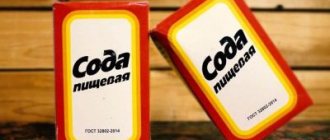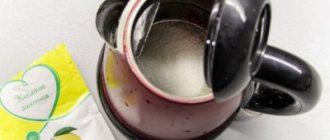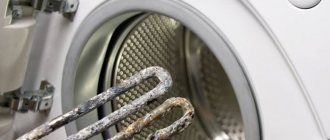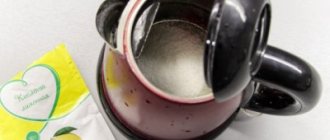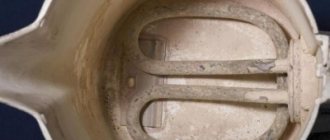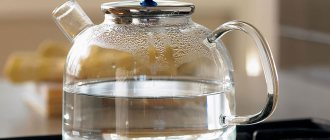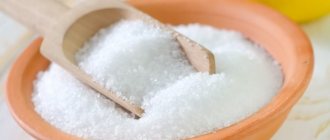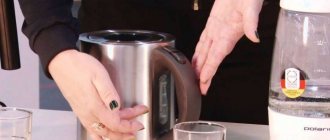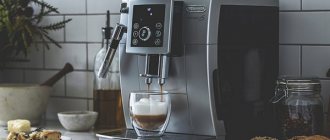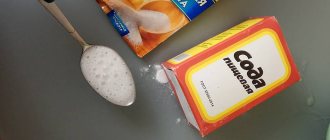Scale forms on all appliances in which water is heated. Solid deposits reduce the thermal conductivity coefficient, which causes more electricity or gas to be wasted.
In some cases, scale can cause the appliance to break down.
You can cope with the problem using household chemicals and folk remedies. Read the article about how to remove scale from different surfaces.
Why does it work
Arina Piskareva
Laboratory employee of the Department of Bioengineering, Moscow State University
Scale is mainly composed of calcium and magnesium carbonate. When interacting with citric, acetic, orthophosphoric or other acid, sparingly soluble carbonates of alkaline earth metals are converted into readily soluble salts. For example, acetates. Therefore, acidic substances are effective in the fight against scale, and to enhance the reaction they need to be heated.
Soda, when interacting with water, produces carbonic acid molecules, which, in turn, react with insoluble calcium and magnesium carbonates, turning them into soluble bicarbonates. And they are easily washed off with water and removed with a sponge.
Method 9: Use brine to clean teapots
Frankly speaking, this method is not for everyone. It's hard to imagine a person who likes the smell of boiling brine. However, if you are not sensitive to fragrances and the naturalness of the product is important to you, you can experiment.
It is necessary to pour the brine into the kettle, boil and leave for half an hour. Then drain the brine and rinse the kettle with clean water.
Not everyone will like boiling brine.
True, not every brine is suitable - only one that contains vinegar or citric acid. It is through their action that the effect is achieved. But here the question arises: why boil the brine if you can just use acid or vinegar?
For which teapots is it not suitable or suitable?
The market is filled with different teapots. Even in one family, several types of equipment can be used at once, and accordingly, care can be different. Cleaning a kettle from scale with citric acid may not be suitable in every case. There are materials that can deteriorate when interacting with an acidic environment.
Not suitable:
- Enameled teapots cannot be cleaned with lemon or other acid-containing products. The enamel becomes thinner and the equipment will quickly become unusable. In this case, soda is more suitable for cleaning. A tablespoon of the product should be dissolved in water, boiled and drained, and then wash the product. Folk remedies include peeling apples and pears. Simply place the fruit scraps in a kettle of water and boil them. A small amount of acid washes away the scale. The method works only for minor contamination;
- Plastic electric ones - here you need to be more careful with acids and use more gentle products. If you don't know how to clean an electric kettle, try making a weak solution of citric acid and leaving it for a couple of hours. The appearance of such products is tidied up using soda dissolved in water. You can make a thin paste, apply it to the stains and after a while, gently rub. And, of course, no vinegar or direct aggressive effects of acids - plastic does not like this. It should be noted that plastic kettles are cleaned much faster than their metal or enamel counterparts.
Fits:
- Metal ones can be easily cleaned with lemon or vinegar. You can boil an acid solution in them, this will not affect the quality of the device. Baking soda diluted in water is also suitable for washing. Do not use abrasive materials, only soft brushes, sponges and cloths;
- Electric ones made of heat-resistant glass - the use of acid will not only quickly clean such a kettle, but also give it shine. Usually there is no sediment left on the glass, but the heating bottom may be dirty. Boil water with acid, rinse well and wipe from the inside. Citric acid will help remove traces of dirt from the outside of the electric kettle. And of course, no hard brushes or metal sponges;
- Thermopot is a very convenient thing to have in the house, but there are difficulties in cleaning it due to the structure and weight of the thermopot. But here citric acid comes to the rescue. It is more effective than baking soda and does not have a strong odor like vinegar. You need to pour a packet of acid into the thermopot and boil the solution. Drain the water and wipe the walls and bottom with a soft cloth. A final boil can be carried out.
Enameled
Plastic
Metal
Electric glass
Thermopot
Citric acid is often used to clean various surfaces or household appliances. Its effectiveness has already been proven by many housewives. You can try it too. How to descale a kettle with citric acid? Do the following:
- Prepare one or two packs of citric acid. It should be in powder. The volume of the substance will depend on the amount of scale in your kettle. The more advanced the situation, the more acid will be needed to correct it.
- Pour citric acid into the kettle container.
- Pour water to the level reached by the scale layer.
- Bring the water to a boil and maintain this process for 5 minutes.
- Drain the hot water with citric acid and rinse the kettle with fresh water.
If there is too much scale, then all this can be repeated several times until the walls of the kettle are clean. You can also replace rinsing by repeatedly boiling clean water.
Usually dilute 10 grams of citric acid per 1 liter of water. The product package usually contains 25 grams. But still check the dosage. To descale a kettle with citric acid correctly, it is important to maintain the proportions.
Sometimes this procedure is not enough. But even in this case, you can descale the kettle with citric acid. Just before using it, boil water with the addition of one teaspoon of soda. It will soften the scale, and citric acid will finish the job.
You can descale a kettle with citric acid without using powder. Just take the fruit itself. Select a large lemon and cut it in half. Rub the sides of the teapot thoroughly with a piece of fruit. Wait a bit. Then cut the lemon, add water and boil. Let the broth sit for about 20 minutes. Then drain it and rinse the dishes.
As you can see, descaling a kettle with citric acid is not difficult. This procedure does not take much time. In addition, this method can be called budgetary, since it does not require significant financial costs.
Scale also forms on iron kettles. It's more difficult to get rid of. What to do to remove scale from a kettle with citric acid? To do this, you will have to use not only this product, but also vinegar.
How to descale a kettle with citric acid? Fill half a kettle with water and add half a glass of vinegar. Wait 10-15 minutes for the product to begin to slightly corrode the scale. After this, add one tablespoon of citric acid to the water and boil it. As soon as the liquid begins to bubble, turn off the kettle and leave it for 20 minutes.
During this time, the scale should soften well. It can be removed with a regular washcloth and dishwashing detergent. We descale the kettle with citric acid. It can be poured onto a washcloth. Scrub the sides of the kettle thoroughly and rinse it with water many times. At the end, you can boil the water in it again and pour it out.
As mentioned above, scale can be dealt with in different ways. It’s clear how to descale a kettle with lemon. But besides this, there are some other remedies that are no less effective. You might like one of these methods.
You can clean the kettle with Fantoy, Coca-Cola or Sprite. These drinks contain ingredients that can quickly soften the scale in the kettle. How to use them? Open the soda bottle for a while to release the gas from the water. After this, pour it into the kettle to the level to which scale has formed on it.
Do not use soda to clean your electric kettle. This way you can simply ruin it.
You can use soda, vinegar and citric acid to clean the kettle, but not at the same time, but in turn. Boil water with each product. After three boils, the scale will either simply be washed off when rinsing, or can be easily removed with a sponge. Usually after this procedure the kettle remains perfectly clean.
Some housewives remove scale with cucumber pickle. This product contains citric acid. Place the cucumber brine in a kettle and boil. After this, clean the dishes and rinse. It is worth noting that cucumber pickle also removes rust stains on iron well. This can happen if the kettle has chips.
We suggest you familiarize yourself with How to clean a frying pan from old carbon deposits and grease at home?
Also, to remove scale, boil potato or apple peelings in a kettle. They also contain some citric acid. True, it is only enough for a small layer of scale.
If you don’t want to waste time on folk remedies, you can always buy special chemicals in the store that will clean your kettle very quickly. But be careful when rinsing dishes. It is important to wash out purchased products completely so that they do not remain in the kettle when the water is subsequently boiled. Indeed, in this case, chemicals can enter your body, which is clearly not beneficial for it.
Depending on the type of kettle (electric, enameled, glass) and the amount of precipitation on it, various recipes for removing salt deposits are used.
- Suitable for any kettles, coffee machines, irons, washing machines.
- Proportions: teapots, coffee machines and irons - 10 g for every 100 ml of water; washing machines - 50 g per kilogram of load.
- Pros: environmentally friendly, safe, affordable, pleasant aroma.
- Cons: does not cope with old, thick scale.
Fill the kettle about ¾ full with water, so that the liquid covers the deposits on the walls and heating elements, but does not splash out when boiling.
Pour citric acid into a kettle (100 g of powder for every liter of water) and boil.
Leave until completely cool. Drain the water, remove any remaining plaque with a sponge and wash thoroughly.
For a coffee machine, it is necessary to prepare a solution of citric acid based on the volume of the water reservoir. For example, if the coffee machine is designed for 2 liters, you will need 200 g of citric acid.
Pour the hot solution into the tank and leave for 60 minutes.
After an hour, start the coffee program without the coffee itself. Drain the liquid through dispensers.
Then run the coffee machine with only water, without citric acid. As soon as you pour out the boiling water, you can use the device. If the coffee machine reservoir is removable, remove any remaining deposits under running water.
Prepare a solution for the iron: add 10 g of citric acid for every 100 ml of boiling water, stir and cool to room temperature. Remove the anti-lime rod, if present, and soak in the resulting solution for an hour.
If not, pour the solution into the water tank. Turn on the iron and, holding it vertically, release steam until all the liquid is used up. It is better to do this over a bathtub or basin: along with the steam, scale will fly out of the holes in the sole.
After the procedure, rinse the iron reservoir with running water and wipe the sole with ammonia or nail polish remover.
To remove plaque from the heating elements and drum of the washing machine, you will need 50 g of acid per kilogram of load.
Place ¾ citric acid (190g acid per 5kg load) into the powder tray and ¹⁄₄ (60g) directly into the drum. Run the wash at maximum temperature.
- Suitable for any teapots.
- Proportions: 1 tablespoon of soda, 1 tablespoon of citric acid and a glass of vinegar per liter of water.
- Plus: it even breaks up rock salt deposits.
- Disadvantages: troublesome, strong smell, exposure to aggressive components on devices.
How to clean different devices and surfaces?
Depending on the type of heating device, the methods for removing limescale will differ.
From the iron
To remove scale from the iron, you will need a cleaning solution (you can use soda, citric acid, vinegar and other products), which is poured into the water tank.
The iron is heated, lowered with the sole down, holding it suspended . Using the steam function, rinse the device until the cleaning solution is completely removed. A basin is used to collect liquid with salt deposits.
Read more here.
From the water heater
To clean the boiler, you need to drain all the water from it and close the water supply taps. Then remove the heating element (to do this you will need to unscrew the lid). The heating element is placed in a cleaning solution, for example, with acetic acid and left for 30-60 minutes.
It is necessary to ensure that during processing the composition does not get on the sealing rubber bands . When the scale has dissolved, the device is rinsed with clean water and returned to its place. Read more about removing scale from a water heater heating element here.
From the washing machine
To get rid of scale in your washing machine, it is better to use specialized detergents, strictly following the instructions. This is the only way to guarantee that an expensive device will not fail.
If a powdered product is used for cleaning, it is poured into the drum or into the washing powder section. The liquid is poured into the rinse aid reservoir. All that remains is to start the wash cycle (without clothes) and wait for it to complete.
This and this article will tell you about descaling a washing machine.
From the kettle
The easiest way to clean a kettle is. The washing solution is poured into it, brought to a boil and left to act for 30-60 minutes.
Then you need to drain the composition with the scale dissolved in it. Before using the device again, rinse it thoroughly . The water is drained several times.
When starting cleaning, you must warn all household members that there is a caustic solution in the kettle. This will avoid accidental poisoning. Read more about ways to descale a kettle here.
From thermopot
Thermopot is an improved alternative to an electric kettle , but it is not protected from the formation of limescale. You can cope with the problem using improvised means (vinegar, soda, acid) or household chemicals.
Pour the selected solution into the container, bring it to a boil, cool and drain. If necessary, the procedure is repeated. Read more here.
From a coffee machine
To descale a coffee machine, you need to pour the solution into the water tank and put the device into operation. When the liquid boils, the device is turned off, but it is not drained immediately . The composition needs time to dissolve limescale. This will take about half an hour.
After cleaning is completed, the device must be turned on by running plain water through it. You can make coffee only after rinsing.
To remove scale, use both improvised means and professional household chemicals. Details are in this article.
From the pan
To remove scale from a pan, pour a cleaning agent into it, put it on fire and cover with a lid. When the liquid boils, turn off the gas.
After 30 minutes, the water must be drained . If necessary, gently rub the surface with a soft brush.
The pan, cleared of salts, is rinsed several times with clean water, after which it can be used as usual. Read more here.
From a steam generator
To remove scale from a steam generator, use citric or acetic acid. Household cleaners do a good job.
To remove salt deposits proceed as follows:
- drain water from the boiler;
- pour the prepared solution into it;
- close the valve;
- turn on the device to maximum heat;
- iron unnecessary fabric, constantly supplying steam;
- turn off the device and allow it to cool;
- drain the remaining liquid and rinse the tank.
If the device is heavily clogged, splashes will fly out of it. You need to work carefully so as not to get scalded.
From a humidifier
Instructions for descaling the humidifier :
- Drain the water.
- Remove dirt with a soft cloth.
- Pour an acid-based cleaning solution into the reservoir.
- Leave to act for 3-5 hours.
- Rinse all elements with clean water.
You cannot connect the device to the network while the solution is in it. It is recommended to use non-aggressive compounds, for example, citric acid.
How to clean scale with soda, citric acid and vinegar
- Suitable for glass and ceramic teapots, stainless steel kettles, irons and washing machines.
- Proportions: teapots - 100 ml for each liter of water; irons - 1 tablespoon per liter of water; washing machines - 10 ml per kilogram of load.
- Plus: a more aggressive acidic environment removes even a thick layer of scale.
- Cons: may harm rubber and plastic elements of devices, pungent odor.
Drain and refill the kettle with water. Boil it and pour in vinegar. Leave for 15–20 minutes.
If after this the scale does not come off on its own, it will become loose. You can easily remove it with a sponge and dishwashing detergent.
At the end, boil clean water in the kettle again and then drain it.
How often to perform the procedure
Usually the procedure is carried out as needed. The presence of scale on the walls is determined visually and by touch:
- The inner walls become rough.
- A light yellow, gray or brown crust forms.
- When rinsing the kettle, the water comes out with crumbs.
- Glass walls become cloudy.
On average, scale forms in 2-3 weeks.
But with frequent use of the device, as well as boiling hard water, the process can speed up significantly. Therefore, it is correct to focus on your observations. Don't start the kettle. The resulting plaque quickly hardens, and the layer of scale thickens.
Scale in a kettle: how to remove with citric acid?
- Suitable for any teapots, coffee machines.
- Proportions: teapots and coffee machines - 1 tablespoon for every 500 ml of water.
- Pros: accessibility, simplicity.
- Cons: does not remove all types of plaque, does not cope with old deposits.
The mechanism for cleaning teapots and coffee makers with soda is simple: fill them with water, add soda and boil. In this case, it is recommended not to remove a regular kettle from the heat for another 20–30 minutes after boiling, and to turn on an electric kettle several times.
After the procedure, wash the inside of the kettle or coffee machine reservoir and boil clean water.
Household anti-scale chemicals
There are now a large number of special means to combat scale. They are available in three forms: powder, tablets and liquid. Let's take a closer look at some of them:
HG is a descaling agent. It copes with it not only in the kettle, but also in all other household appliances - washing machines, dishwashers and so on. Its advantages are:
- efficiency;
- economical consumption;
- safety and harmlessness for equipment and people;
- does not leave streaks;
- has no smell.
It is not desirable for aluminum kettles, but who has them now?
Bagi Kumkumit - copes well with deposits in teapots, coffee makers and other household appliances. Very good because:
- contains citric acid;
- removes not only plaque, but also rust;
- safe for equipment and people;
- is used sparingly;
- has a pleasant smell.
No deficiencies identified
Luxus Professional is universal, suitable for cleaning any household appliances. Its advantages:
- safety;
- plant composition;
- prevents the appearance of scale;
- has a pleasant smell.
However, it does not always solve the problem in one go.
Cinderella "Antinakipin" is a domestically produced liquid product. It contains organic and mineral acids and copes well with scale. Its advantages:
- gives quick results;
- has no smell;
- affordable price.
No cons identified
Eona Bio is another domestic product. It:
- effective;
- inexpensive;
- without smell;
Well, we've dealt with the scale. How can I avoid its reappearance? Let's talk about prevention.
Preventing scale formation
It often happens that the kettle is so dirty that ordinary cleaning with citric acid no longer helps. Most often, a layer of lime deposits immediately catches your eye and it is not always clear what to do with it; will you really have to throw away the kettle? Before you take drastic measures, try the following tips.
- How to descale a kettle if there is a thick layer of mineral deposits in it? You need to pour a saturated solution of citric acid into it for several hours, and then boil it. If after this the layer just begins to peel off, repeat the procedure. If necessary, soak for at least five hours;
- Suitable cleaning methods can be combined. For example, apply a paste of soda and water to the walls and bottom of the kettle, leave for several hours, and rinse. Take water with the addition of one or two sachets of citric acid and boil the solution, then remove the plaque;
- If the plaque is long-term and persistent, a “nuclear” scheme is used, consisting of three points:
- Pour 4 tablespoons of soda into a kettle, add water and boil for half an hour. Then drain the water;
- Pour water into the kettle again, but now with the addition of two bags of lemon powder. Don’t rush to put it on the stove, let the solution soak the rock-salt deposits. This will take at least three hours;
- Check to see if the scale has loosened, then you can start cleaning. If not, boil the solution for half an hour.
Boil with soda
Next, boil with lemon
Checking
You won’t have to waste time and effort fighting plaque on the walls of the kettle if you prevent the problem in time. You need to know the rules for operating equipment, as well as systematize its care.
Make it a habit:
- Using soft water. This can be filtered or bottled drinking water. As a last resort, fill water in bottles in advance so that it settles and hard impurities settle;
- One-time boiling. Many people have the habit of boiling the same water in a kettle several times. This can affect not only your health, but also the operation of the device. Each time you are going to boil water, pour in a fresh portion;
- Preventive boiling of water with citric acid. There is no need to wait for scale to form, just prevent it from appearing. The kettle needs to be cleaned with acid twice a month. This way the product will last you longer and you will save time. You can get by with just soaking for half an hour;
- Clean the walls and bottom of the kettle every day. Every day we pour a new portion of water before drinking tea. This means that we need to rinse the device every day before use. If every person followed this completely logical and simple rule, then there would be no problems with descaling the kettle.
The scale problem cannot be ignored. The rock-salt layer at the bottom of the container from which you are going to drink should raise suspicion. Why you shouldn’t allow plaque to form:
- Harm to the body. One way or another, scale is not just sediment on the walls of the kettle. Its particles float in the water that covers the contaminated walls. If deposits enter the body along with tea or coffee, the stomach will not digest them. This can cause malfunction of internal organs. It is no secret that poorly filtered water causes urolithiasis, osteochondrosis and gout. In addition, porous formations can become a haven for microorganisms that can multiply right in your kettle;
- Damage to technology. In most cases, it is scale that causes the kettle to break down. This is especially true for electrical appliances. Rock-salt deposits delay heat removal. The product overheats to unacceptable temperatures and soon burns out. Owners of enamel teapots may also suffer. The scale will interfere with heating, and the water will begin to boil later than usual. This way, more electricity or gas is wasted. And in the end you will lose the kettle too.
Getting rid of scale at home, especially in the early stages, is not so difficult. But it’s easier to get into the habit of caring for your household appliances. Thus, you prolong its life, save time and money. The use of citric acid is suitable for preventing the formation of mineral deposits on the walls of dishes; This is an inexpensive, environmentally friendly product without an obsessive odor.
Use soft water
Don't boil the same water more than once
Preventative boiling
- Try to pour only filtered water into kettles, coffee machines and irons.
- Rinse the appliance before adding water.
- Do not leave water in the appliance after use. It's better to pour a new one each time.
- Get rid of scale at least once a month, even if there is no pronounced plaque on the heating elements and walls. If the device has a self-cleaning function, use it.
We suggest you read: The bottom of a stainless steel pan is burnt, how to clean it
There are simple rules for caring for a kettle that should be followed:
- To ensure that the heating element and the inside of the product are not often covered with a layer of scale, use only clean water. You can use purified with a filter or buy bottled. If this is not possible, always allow tap water to sit before boiling. Only after this pour it into the bowl.
- Do not boil the same water several times. The best option is to replace it with a fresh one each time.
- Clean the inside of the kettle before use. Make sure there are no white flakes in the water.
- If after each use or at least once a day, in the evening, you wipe the inside of your favorite kitchen utensils dry, then scale will appear less often, and the product will last you much longer.
You can remove scale from a kettle using citric acid. But it’s better that she doesn’t appear there much. To do this, for the sake of prevention, boil this product with water once every two weeks. In this way, the scale will be constantly softened and removed. It will not be able to settle on the walls of the dish in a dense ball.
If you don't want to spend time on this, you can simply wash the inside of the kettle once every few days. So the scale simply won’t have time to debug.
Avoid using metal scrapers or scourers. They will leave scratches on the walls of the kettle. They will become ideal grooves for further scale deposits.
Do not leave water in the kettle for any length of time, especially overnight. During this time, salts will have time to settle on the walls, which will not be easy to remove.
Scale is formed from salts that are present in water. It is clear that there are more of them in tap water than in filtered water. To prevent large amounts of scale from forming and harming your health, use water filters. It is best to purchase one that attaches to the faucet. Do not forget that the cleaning media in the filter must be changed periodically.
Do not boil the same water several times. This will provoke the deposition of more and more salts. After each boil, rinse the kettle to remove all the white flakes. Otherwise, during subsequent boiling, they will begin to dissolve, making the water very harmful to the human genitourinary system and kidneys.
If you notice that it still appears, then do not hesitate to cleanse it. The sooner you take care of your kettle, the faster it will become the way you need it.
How harmful is limescale from a kettle?
Finally, I would like to say that scale is a complex mixture consisting of metal salts and chlorine. Since water for the kettle is most often drawn from the tap, a large amount of scale forms on the heating element.
The dangerous compounds that make up the white plaque have a toxic effect on our body. They get inside through boiled water and are not tasted, but cause colossal damage to health.
As a result of regular consumption of water with scale, liver and kidney diseases develop, and problems with the stomach and intestines arise. Therefore, it is recommended to get rid of scale every month, at least.
Citric acid or juice are quite effective products that, when used regularly, protect the kettle from the formation of white deposits. The device will always be clean and will last a long time, and your health will remain in perfect order.
How to descale with soda water
- Suitable for any teapots, coffee machines, irons.
- Proportions: the vessels are filled approximately ¾ full.
- Plus: effective even with thick plaque.
- Disadvantage: a colored drink may stain the vessel. Therefore, to clean irons and white plastic electric kettles, it is better to use clear soda, including mineral water.
Open the bottle and wait until most of the carbon dioxide has evaporated.
Pour the soda into the kettle or coffee maker reservoir, hold for 15–20 minutes, and then boil.
Thanks to phosphoric acid and carbon dioxide, sodas do an excellent job of removing salt deposits.
Method 4: Clean the kettle with soda
An inexpensive and healthy way to get rid of even the oldest and hardest scale is to use baking soda. It is suitable for all types of teapots, including enameled ones.
It is important not to overexpose the soda in the kettle
However, you should use baking soda carefully - it can scratch the surface, so don't try to just wipe off the plaque with it. In addition, in order to get rid of the old layer of scale, you will have to repeat the procedure at least three times.
Add one tablespoon of soda to half a kettle of water (no more!). For a regular kettle, boil the water for half an hour. For electric, you need to turn on the boiling mode several times. Forum users claim that three to four times are enough.
What to do to prevent scale
No boiling
If there is reason to believe that the device will deteriorate during heat treatment, the plaque can be removed without boiling. To clean the kettle with citric acid, dissolve a packet of product (20-25 g) in warm water, pour the solution into a container and leave overnight. During this time, the scale will soften, all that remains is to rinse the dishes to remove any sediment.
Don't forget to boil the kettle with clean water to wash away any remaining product.
After settling, the plaque should settle at the bottom, after which it must be washed with water
If you don’t have acid powder on hand at the right time, and the cleaning procedure needs to be carried out immediately, an ordinary lemon will come to the rescue. Fresh citrus helps to safely remove stains from glass teapots, ceramic and stainless steel items, as well as enameled ones. This method can be safely used even to clean a baby’s dishes.
Use fresh lemon instead of acid for descaling
Take the fruit and cut it into thin rings along with the skin. Place the pieces in a teapot and fill 2/3 full with water. Turn on the device or put it on fire, bring the mixture to a boil. Remove the softened sediment from the container along with the remaining citrus, and rinse the dishes thoroughly. If the contamination is strong, you will have to use 2-3 lemons and fill the container at least halfway.
Citric acid and vinegar will help descale a metal kettle for a gas stove. Pour half the volume of water into the bowl and add half a glass of 9% vinegar. Let it sit for 15-20 minutes for the substance to take effect, then add 1 tablespoon of lemon powder and bring the solution to a boil, then turn off and leave to infuse for half an hour.
Then the liquid is drained, the kettle is washed inside with a damp sponge with dishwashing detergent and rinsed thoroughly under running water until the foam is completely washed away. Carry out the manipulation with rubber gloves so that the concentrated acid solution does not damage your hands.
In addition to lemon juice, you can use vinegar and baking soda for cleansing.
The following method is not suitable for electric kettles, but is especially effective for metal products. Pour water into the dishes prepared for cleaning, add 1 tbsp. l. baking soda, boil the solution for 5 minutes and drain the liquid. Next, add water with 1 tbsp. l. acid and boil for about 30 minutes over low heat.
Drain the solution again, add fresh water, add 100 ml of vinegar and boil again for half an hour. Such shock cleaning is carried out in the most advanced cases. If the scale does not move away from the walls after this, then it will at least become loose and can be removed with a regular sponge.
Unlike other methods, descaling products with lemon powder can be done quite often - 1-3 times a month, depending on the level of water hardness. This procedure will not only extend the life of the electrical appliance, but also preserve your health.
An electric kettle or a traditional metal one will eventually become covered with scale on the inside. The reason is simple. The fact is that water contains various salts, which form a hard coating on the walls, bottom, and also on the heating element. Lime deposits occur especially quickly from excessively hard tap water. However, filtered and bottled water only temporarily delays the appearance of scale. This means that serious cleaning of kitchen utensils is inevitable.
We suggest you read: How to clean a ceramic frying pan
Each housewife has her own methods with which she copes with this kind of pollution. For example, someone is trying to get rid of scale with detergents. We do not recommend that you do this. After such cleaning, during subsequent boiling, chemicals will be released into the water. Drinking such liquid is very harmful to health.
Under no circumstances should you use abrasives, hard sponges, scrapers or metal meshes. They will damage the inside of the product or the heating element, after which it may be damaged. You can wash the kettle quickly and easily using citric acid.
Why do we recommend descaling with citric acid? Because this product is quite affordable, you don’t have to spend a lot of money on it. In addition, it is completely safe and will not harm your health in any way. There are several effective techniques. For old thick plaque, the so-called hot method is used. If the contamination is not too strong, then the cold method is suitable. Now is the time to move on to the sequence of actions and description of proportions.
How often should I clean?
The kettle needs to be cleaned regularly. If you carry out the procedure at least once a month, scale will not form. The cleaning time depends on the quality of the tap water.
If it is soft, then scale forms slowly. In this case, treatment can be carried out once every 1.5-2 months. If the water is hard, limescale deposits quickly. Therefore, preventive cleaning of the device is carried out once every 3-4 weeks.
Citric acid does not harm the kettle even with frequent contact with its walls.
How to properly clean the inside?
If the scale layer on the inside is not too severe, you will need 50-60 grams of citric acid. Pour it into the kettle, fill it to the top with very warm water, stir thoroughly. Leave for about an hour, or even better, two. After waiting the time, you just need to pour out the liquid and rinse the kettle with plenty of water. You will notice that the inside of the product has become much cleaner, the plaque has disappeared.
Such regular prevention, at least once or twice a month, will avoid the accumulation of stone deposits and preserve the dishes. The kettle will look like new for a long time.
If there is a thick layer of scale and the above method does not help, you will have to use a more serious method - hot cleaning. To do this, you will again need the kettle itself, citric acid and water. Pour water to the top, add two tablespoons of citric acid and boil the water. Turn off the heat and leave to cool completely. Remember: after each procedure the water is drained.
If small traces of plaque remain on the walls or bottom, remove them with a soft sponge. Did not help? You can safely repeat the procedure. After the second bath, the scale is guaranteed to disappear. Another recommendation regarding the hot method. Never add acid powder to boiling or very hot water.
A little advice on getting rid of old scale. We recommend making this “paste” in the evening. Take equal parts baking soda, which you usually use for baking, and citric acid. Dilute with a small amount of water to end up with a thick paste. Apply it to problem areas and leave overnight. The next morning, you can use any of the cleaning methods we told you about.
Another proven method that will definitely help you cope with even an annual layer of plaque is using a mixture of table vinegar and citric acid. The combination of these two ingredients is well known to many housewives who regularly clean various kitchen utensils.
We warn you that the vinegar should not be “strong”. That is, 70% acid is absolutely not suitable. Take the vinegar that can be used in food: its percentage is much lower, but the effect will be amazing. Please note that using vinegar is absolutely not suitable for cleaning electrical appliances, as it can seriously damage the integrity and performance of the heating element.
If you decide to clean an enamel or iron teapot using this method, remember the recipe. So, to clean the kettle you will need citric acid and table vinegar. To a glass of warm water you need to add 3-4 tablespoons of regular vinegar. The liquid should be poured into the kettle and left for about half an hour. Then add 2-3 tablespoons of citric acid and put the kettle to boil. If necessary, the procedure can be repeated.
How can you deal with heavy plaque at home?
If the coating on the walls of the device is heavy, the following tips will help you deal with it:
- To remove a thick layer of salt deposits, you need to use either specialized compounds or increase the concentration of folk remedies.
- The cleaning procedure is repeated several times.
- If necessary, you can clean off the softened deposits with the hard side of a foam sponge.
- The holding time of the cleaning composition is increased by 2 times.
It will not be possible to deal with a strong coating in one go, so the cleaning will have to be repeated. If there is no time, you can carry out the procedure in a few days.
How to clean the outside?
Very often teapots, now we are not talking about electrical appliances, lose their appearance. An enameled or metal product becomes stained with grease, carbon deposits and even rust appear. What to do in this case? I would like all kitchen utensils to shine with their pristine shine and cleanliness, and not scare away with their terrible appearance.
Don't worry, there are tips for this case too. As before, you will need citric acid. Small oil stains and burnt fat can be removed with a lemon peel. Simply take a lemon peel or a citrus slice and rub onto the affected areas. Stains will come off easily, and you can easily wash the dishes with a soft sponge.
If the dirt on the surface is too serious, then prepare a special cleaning solution in a large container. You will need a large container that can completely immerse the kettle. Add 100-150 grams of citric acid to warm water, then immerse the kettle there. Leave for about an hour. It is important to remember here: the hotter the water, the more acid, the faster the cleaning process will take place.
Old stains that periodically appear after cooking can be easily removed using a “paste” of acid and baking soda. We talked about the preparation of the mixture and the consistency of the cleaning solution above.
Method 3: Clean the kettle with vinegar
First of all, it should be noted that this technique is not suitable for electric kettles: vinegar can only be used for ordinary metal ones. However, for them this method is very effective and convenient.
As in previous cases, you need to fill the kettle two-thirds full. Add vinegar, about half a glass per liter. If you are using concentrated essence, you will need one and a half tablespoons for the same amount of liquid.
Measure the amount of vinegar carefully
Boil water and leave to cool for one hour. Then simply drain. Use a soft sponge to wipe stubborn stains and they will come off. After cleaning, you need to boil the kettle with plain water two or three times.
Important : Please note that vinegar emits a very strong aroma when heated, so you should only carry out the procedure with the windows open or a powerful hood turned on.
Recommendations and tips
Finally, we have prepared a few more useful tips that will help you keep your kettle in perfect condition:
- If there is no citric acid in the house, then it is quite easy to replace it with regular citrus fruit. You can squeeze the juice from one lemon, or you can simply cut it into small pieces and use it in the methods for getting rid of plaque that were described above.
- In some cases, for example, for cleaning an iron kettle, ordinary baking soda is quite suitable, as it can also cope with severe stains.
- If you decide to use a mixture of citric acid and baking soda, but these powders are not in the house, then this is not a problem. They can be safely replaced with regular baking powder or baking powder. Their wonderful composition, which helps baked goods become more fluffy, already contains both soda and acid.
- Fans of carbonated drinks, particularly lemonade, can use them as cleansers. You just need to pour the lemonade into a container and leave it there for two or three hours. Leave the lid open to allow all the gas to escape. Then you need to boil the drink in your favorite kettle and that’s it. The result will be pleasantly surprising. Try to use clear drinks, otherwise you risk staining the inside of the glassware a toxic color.
- It will become easier to care for heat-resistant glassware if you wipe it twice a month with a slice of lemon on all sides: outside and inside. By the way, if you don’t have citrus at home, you can take the powder with lemon and dilute it in water. It is better to clean the contaminated surface with a soft sponge or sponge, moistening them in the solution.
- The following product copes well with dark soot stains and smudges on metal products. Lemon juice and rubbing alcohol should be mixed in equal proportions, then apply the resulting mixture to the stains using a cotton pad and wipe the surface thoroughly. After half an hour, you can wash everything off. If the result is unsatisfactory, the whole process should be repeated.
To learn how to easily descale a kettle, watch the following video.
Helpful information
Tips to help you quickly and safely deal with lime deposits:
- After treating with any folk or chemical remedy, you need to thoroughly rinse the surface to remove the caustic composition. The ingestion of acids into the body is dangerous to health.
- Do not scrub scale with a hard metal brush or other sharp objects. This will damage the walls of the device. As a result, deposits will grow even faster.
- The cleaning solution should only be used on hard appliances. Do not allow acids to come into contact with rubber bands or other seals to avoid damaging them.
Where does scale come from?
Scale is hard build-up and sediment that appears due to the deposition of chemical elements (magnesium and calcium salts) when exposed to high temperatures (1000). In other words, when water (H2O) boils, the salts are split into two elements - sediment, the one we see at the bottom of the kettle, and carbon dioxide, which evaporates as steam.
In every kettle, sooner or later scale forms - salts of compounds inherent in hard water.
The reason for all this is water hardness. The higher the hardness level, the more minerals in the water. There are 4 degrees: 1 – water quality is normal, 2 – more or less, 3 – poor example of water, 4 – very hard water. Knowing the level of hardness in your home, you can understand exactly how often you need to carry out preventive work.
Scale has a detrimental effect on everything:
- Excess scale on all water heating devices leads to their breakdown.
- The taste of water changes beyond recognition and has a specific smell.
- Increases energy consumption. The device needs to work longer, since it cannot heat the water faster due to plaque build-up.
Scale and rust inside ordinary teapots - metal or enameled - also does not bring joy.
To combat scale, it is important to know what anti-scale products can be used, how to make cleaning more effective and which drugs will 100% cope with the task in a given case.

